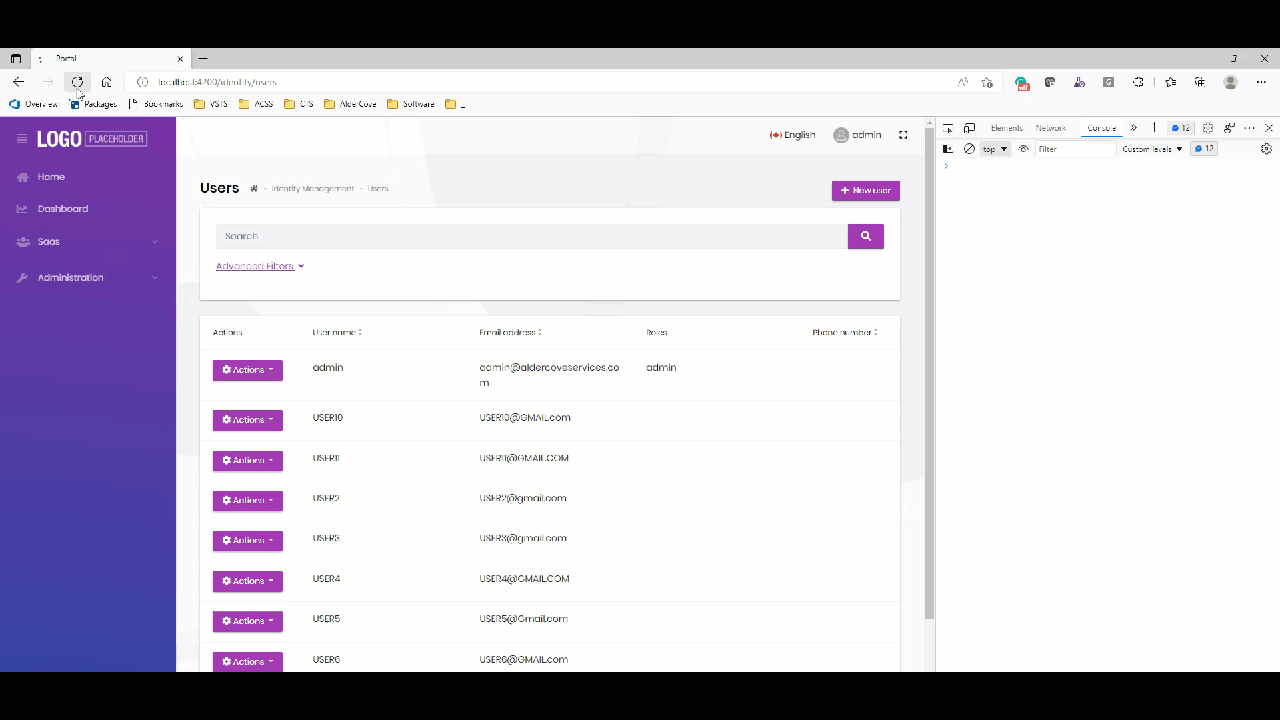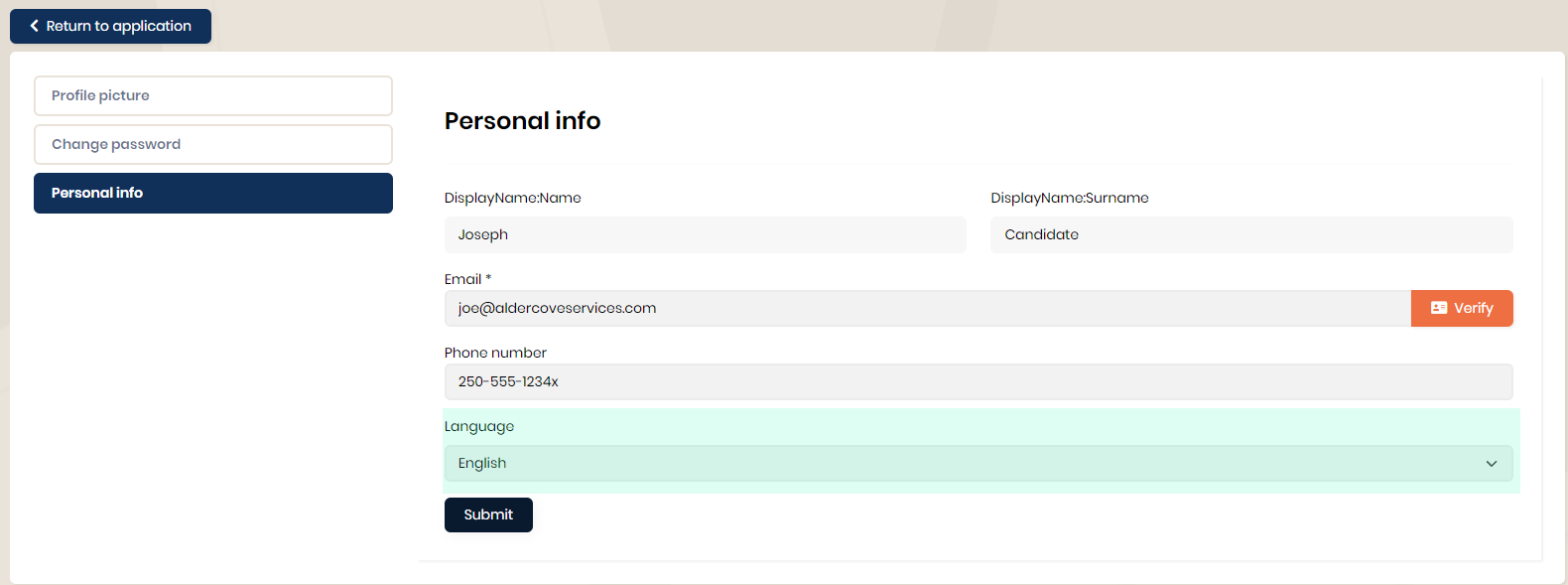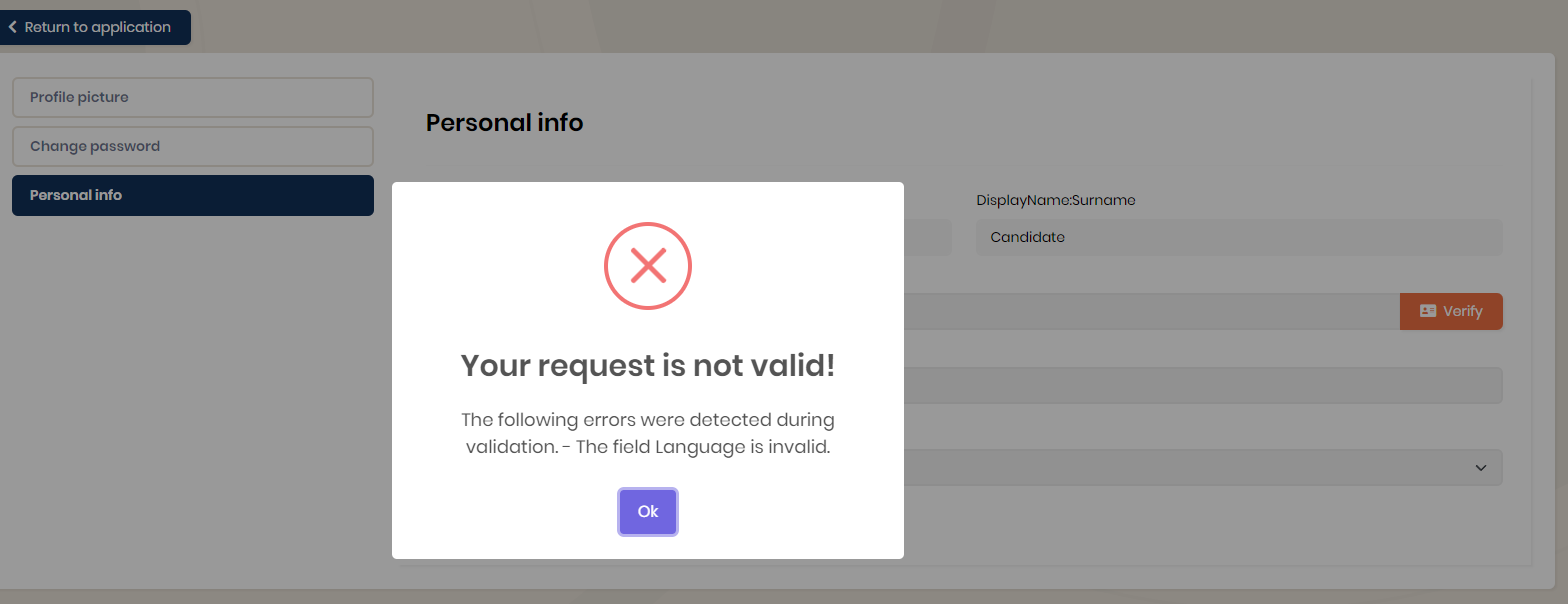Activities of "AlderCove"
- ABP Framework version: v5.1.4 & 5.2.2
- UI type: Angular
- DB provider: EF Core
- Tiered (MVC) or Identity Server Separated (Angular): yes
- Exception message and stack trace: ERROR RangeError: Maximum call stack size exceeded
- Steps to reproduce the issue:
-
- Create new project
-
- Follow ABP Framework Quick example for Module Extension System (https://docs.abp.io/en/abp/5.2/Module-Entity-Extensions#quick-example) to add SSN to YourProjectNameModuleExtensionConfigurator class inside the Domain.Shared project and to add column to table (https://docs.abp.io/en/abp/5.2/Module-Entity-Extensions#database-mapping)
-
- Add migration and update database
-
- Run the projects (API, Identity Server and Angular Apps)
-
- Login to Angular App
-
- Add 10-12 Users
-
- Refresh the page
-
- Observe the error
Hi,
I encountered this issue while adding several properties to the IdentityUser entity and Dtos (v5.1.4) . In my application, this error prevents the Users page from fully loading - some of the columns in the last few rows aren't rendered including the Action menu button.
I was able to reproduce the error with a scratch project (v 5.2.2), by adding a single property to the IdentityUser entity. I followed the Architecture -> Modularity -> Customizing/Extending Modules -> Module Entity Extension System of the documentation for 5.2 to add the SSN to the IdentityUser. I needed to create 12 or so users before the error cropped up:
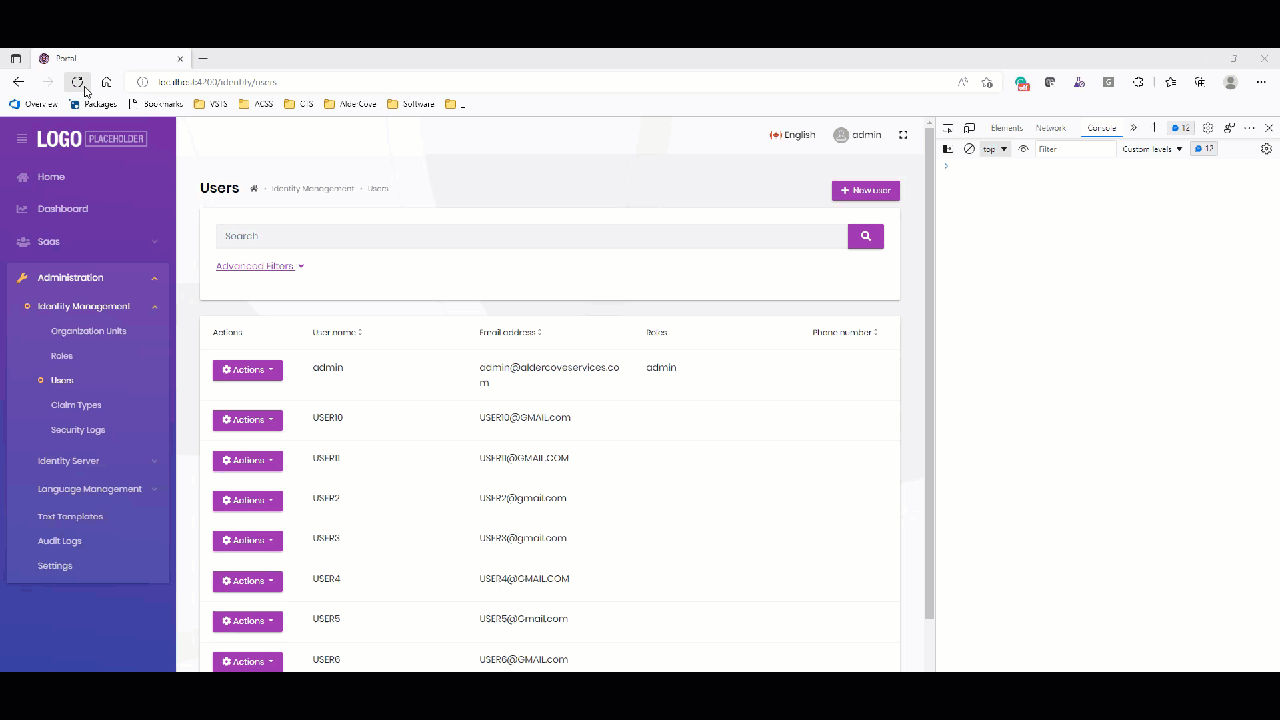
When I remove the configuration for the extra property from the PortalModuleExtensionConfigurator in the Domain.Shared project, and restart the identity server & API, the error goes away:
* See the documentation for more:
* https://docs.abp.io/en/abp/latest/Module-Entity-Extensions
*/
//ObjectExtensionManager.Instance.Modules()
//.ConfigureIdentity(identity =>
//{
// identity.ConfigureUser(user =>
// {
// user.AddOrUpdateProperty<string>( //property type: string
// "SocialSecurityNumber", //property name
// property =>
// {
// //validation rules
// property.Attributes.Add(new RequiredAttribute());
// property.Attributes.Add(new StringLengthAttribute(64) { MinimumLength = 4 });
// });
// });
//});
Appreciate your help.
Thanks Jamie
- ABP Framework version: v5.1.4
- UI type: MVC
- DB provider: EF Core
- Tiered (MVC) or Identity Server Separated (Angular): yes
Hi,
Please help me to add keyboard support for sub-menus on the main menu region of the public website.
When the user hovers on the menu item, the sub-menu opens, which is great.
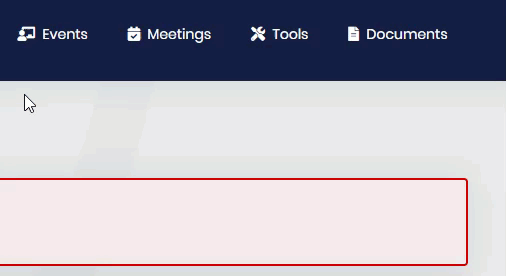
For users navigating with the keyboard, the submenu should open when the user presses enter on the menu item (as described here https://www.w3.org/WAI/tutorials/menus/flyout/#flyoutnavkbfixed).
The current behaviour does not support keyboard access to sub-menus.
I tried adding javascript (from the w3 example) for it in the /Themes/Lepton/Components/MainMenu/_MenuItem.cshtml page without success.
var menuItems = document.querySelectorAll('li.has-drop');
Array.prototype.forEach.call(menuItems, function(el, i){
el.querySelector('a').addEventListener("click", function(event){
if (this.parentNode.className == "has-drop") {
this.parentNode.className = "has-drop open";
this.setAttribute('aria-expanded', "true");
} else {
this.parentNode.className = "has-submenu";
this.setAttribute('aria-expanded', "false");
}
event.preventDefault();
return false;
});
});
Menu configuration from public class PortalPublicMenuContributor : IMenuContributor
// Tools
var tools =
new ApplicationMenuItem(
PortalPublicMenus.Tools,
l["Menu:Tools"],
icon: "fas fa-tools",
order: 6
)
;
context.Menu.AddItem(tools);
// AssessmentTools
tools.AddItem(
new ApplicationMenuItem(
PortalPublicMenus.AssessmentTools,
l["Menu:AssessmentTools"],
"~/assessment-tools",
icon: "fas fa-question-circle",
order: 1
).RequirePermissions(PortalPermissions.PublicWeb.AssessmentTools)
);
// courses
tools.AddItem(
new ApplicationMenuItem(
PortalPublicMenus.Courses,
l["Menu:Courses"],
"~/courses",
icon: "fas fa-graduation-cap",
order: 2
).RequirePermissions(PortalPermissions.PublicWeb.Courses)
);
// LabourMarketInfo
tools.AddItem(
new ApplicationMenuItem(
PortalPublicMenus.LabourMarketInfo,
l["Menu:LabourMarketInfo"],
"~/labour-market-info",
icon: "fas fa-info-circle",
order: 3
).RequirePermissions(PortalPermissions.PublicWeb.LabourMarketInfo)
);
// Resume Builder
tools.AddItem(
new ApplicationMenuItem(
PortalPublicMenus.ResumeBuilder,
l["Menu:ResumeBuilder"],
"~/resume-builder",
icon: "fas fa-file",
order: 4
).RequirePermissions(PortalPermissions.PublicWeb.ResumeBuilder)
);
Thanks
- ABP Framework version: v5.1.4
- UI type: MVC
- DB provider: EF Core
- Tiered (MVC) or Identity Server Separated (Angular): yes
Upon logging into the Public Website (as result of a password reset or navigating to https://portal-identity-dev.com/Account/Login?returnUrl=https%3A%2F%2Fportal-web-public-dev.com%2Fsignin-oidc), the application returns to url ("https://portal-web-public-dev.com/signin-oidc") and a 500 Internal Server Error occurs:
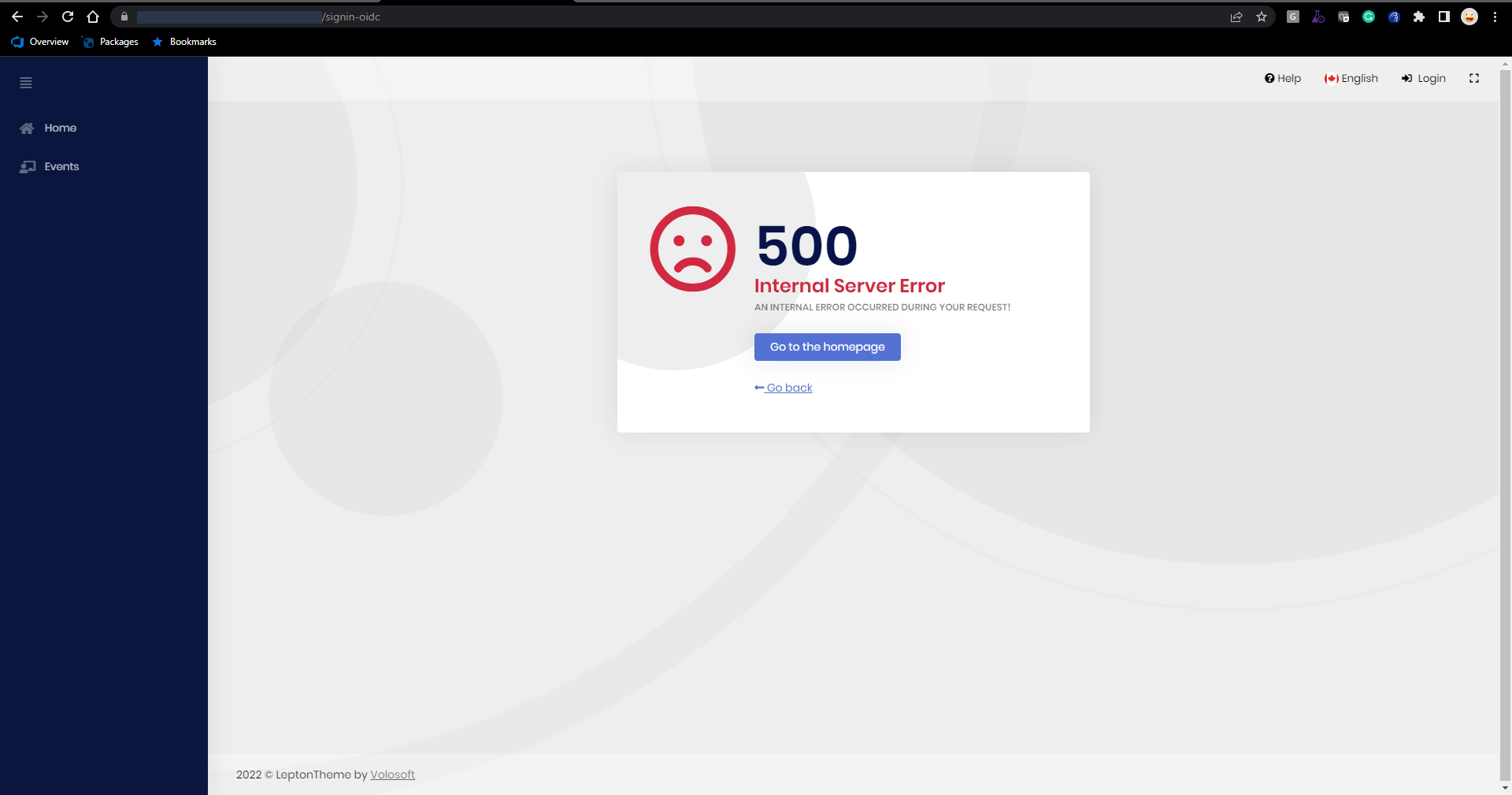
In the public web server log:
2022-06-07 17:56:19.662 +00:00 [INF] Error from RemoteAuthentication: OpenIdConnectAuthenticationHandler: message.State is null or empty..
2022-06-07 17:56:19.663 +00:00 [ERR] An unhandled exception has occurred while executing the request.
System.Exception: An error was encountered while handling the remote login.
---> System.Exception: OpenIdConnectAuthenticationHandler: message.State is null or empty.
--- End of inner exception stack trace ---
at Microsoft.AspNetCore.Authentication.RemoteAuthenticationHandler1.HandleRequestAsync() at Microsoft.AspNetCore.Authentication.AuthenticationMiddleware.Invoke(HttpContext context) at Microsoft.AspNetCore.Diagnostics.ExceptionHandlerMiddleware.<Invoke>g__Awaited|6_0(ExceptionHandlerMiddleware middleware, HttpContext context, Task task) 2022-06-07 17:56:19.663 +00:00 [INF] Executing endpoint 'Volo.Abp.AspNetCore.Mvc.UI.Theme.Shared.Controllers.ErrorController.Index (Volo.Abp.AspNetCore.Mvc.UI.Theme.Shared)' 2022-06-07 17:56:19.663 +00:00 [INF] Route matched with {action = "Index", controller = "Error", area = "", page = ""}. Executing controller action with signature System.Threading.Tasks.Task1[Microsoft.AspNetCore.Mvc.IActionResult] Index(Int32) on controller Volo.Abp.AspNetCore.Mvc.UI.Theme.Shared.Controllers.ErrorController (Volo.Abp.AspNetCore.Mvc.UI.Theme.Shared).
2022-06-07 17:56:19.667 +00:00 [WRN] Could not find IdentityClientConfiguration for AbpMvcClient. Either define a configuration for AbpMvcClient or set a default configuration.
2022-06-07 17:56:19.667 +00:00 [INF] Start processing HTTP request GET "https://portal-api-dev.com/api/abp/application-configuration?api-version=1.0"
2022-06-07 17:56:19.667 +00:00 [INF] Sending HTTP request GET "https://portal-api-dev.com/api/abp/application-configuration?api-version=1.0"
2022-06-07 17:56:20.299 +00:00 [INF] Received HTTP response headers after 631.6003ms - 200
2022-06-07 17:56:20.299 +00:00 [INF] End processing HTTP request after 631.8429ms - 200
2022-06-07 17:56:20.436 +00:00 [INF] Executing ViewResult, running view ~/Views/Error/500.cshtml.
2022-06-07 17:56:20.452 +00:00 [WRN] Could not find IdentityClientConfiguration for CmsKitPublic. Either define a configuration for CmsKitPublic or set a default configuration.
2022-06-07 17:56:20.452 +00:00 [INF] Start processing HTTP request GET "https://portal-api-dev.com/api/cms-kit-public/menu-items?api-version=1.0"
2022-06-07 17:56:20.452 +00:00 [INF] Sending HTTP request GET "https://portal-api-dev.com/api/cms-kit-public/menu-items?api-version=1.0"
2022-06-07 17:56:20.485 +00:00 [INF] Received HTTP response headers after 33.3313ms - 200
2022-06-07 17:56:20.486 +00:00 [INF] End processing HTTP request after 33.559ms - 200
2022-06-07 17:56:20.491 +00:00 [INF] Executed ViewResult - view ~/Views/Error/500.cshtml executed in 54.2382ms.
Pressing the Login button navigates to the identity server and back again with a logged-in state.
I am using docker containers.
Identity server app settings: { "App": { "SelfUrl": "https://portal-identity-dev.com", "ClientUrl": "https://portal-web-public-dev.com", "CorsOrigins": "https://portal-app-dev.com,https://portal-api-dev.com,https://portal-identity-dev.com", "RedirectAllowedUrls": "https://portal-app-dev.com,https://portal-api-dev.com,https://portal-web-public-dev.com/signin-oidc" }, "AuthServer": { "Authority": "https://portal-identity-dev.com", "RequireHttpsMetadata": "false", "ValidIssuers": [ "https://portal-web-public-dev.com", "https://portal-app-dev.com", "https://portal-web-dev.com", "https://portal-api-dev.com" ] }, "ConnectionStrings": { "Default": "Server=XX\data1; Database=Portal; User=sa; Password=XX;" }, "Redis": { "Configuration": "redis" }, "StringEncryption": { "DefaultPassPhrase": "ZY4h7Pg08tNZWA0d" } }
Web Public appsettings: { "App": { "SelfUrl": "https://portal-web-dev.com" }, "RemoteServices": { "Default": { "BaseUrl": "https://portal-api-dev.com/" }, "AbpAccountPublic": { "BaseUrl": "https://portal-identity-dev.com/" } }, "Redis": { "Configuration": "redis" }, "AuthServer": { "Issuer": "https://portal-web-public.com", "Authority": "https://portal-identity-dev.com", "RequireHttpsMetadata": "true", "ClientId": "Portal_Web_Public_Tiered", "ClientSecret": "1q2w3e*", "ValidIssuers": [ "https://portal-web-public-dev.com", "https://portal-app-dev.com", "https://portal-web-dev.com", "https://portal-api-dev.com" ] }, "StringEncryption": { "DefaultPassPhrase": "ZY4h7Pg08tNZWA0d" } }
- ABP Framework version: v5.1.4
- UI type: MVC
- DB provider: EF Core
- Tiered (MVC) or Identity Server Separated (Angular): yes
Hi
For our public website (MVC) project, the users should be directed to the dashboard after successfully logging in, instead of the default home page (index). We don't want them to always be redirected (as described here https://support.abp.io/QA/Questions/2011/Abp-Routing), just after the initial login. The user should be able to navigate to the home page after logging in without being redirected to the dashboard.
Can you please provide some assistance?
Thanks
- ABP Framework version: v5.2.1
- UI type: MVC
- DB provider: EF Core
- Tiered (MVC) or Identity Server Separated (Angular): yes
- Exception message and stack trace: This is a follow-up to my previous issue here, which was closed but not fully resolved: [https://support.abp.io/QA/Questions/2792/How-to-add-to-extend-the-Identity-Server-Personal-info-page#answer-c4fad5d5-e30a-85db-b30b-3a02e5558be9]
To reiterate, I am adding an extra property on the User Personal Info tab for Communication Language, that can be set by the user. I have the property displaying on the view component but updating the value throws an error:
Your request is not valid! The following errors were detected during validation. - The field Language is invalid.
- Steps to reproduce the issue:"
To replace the personal info tab, I did the following in the Identity Server project:
- Created a new class MyAccountProfileManagementPageContributor that implements the IProfileManagementPageContributor interface and removes the framework supplied PersonalInfo tab and adds a custom version in place:
public class MyAccountProfileManagementPageContributor : IProfileManagementPageContributor
{
public async Task ConfigureAsync(ProfileManagementPageCreationContext context)
{
var l = context.ServiceProvider.GetRequiredService<IStringLocalizer<AccountResource>>();
context.Groups.Remove(context.Groups.First(x => x.Id == "Volo-Abp-Account-PersonalInfo"));
context.Groups.Add(
new ProfileManagementPageGroup(
"Volo-Abp-Account-PersonalInfo",
l["ProfileTab:PersonalInfo"],
typeof(MyAccountProfilePersonalInfoManagementGroupViewComponent)
)
);
}
}
- Configured the module to add the MyAccountProfileManagementPageContributor, in the ConfigureServices method:
Configure<ProfileManagementPageOptions>(options =>
{
options.Contributors.Add(new MyAccountProfileManagementPageContributor());
});
- Created a PortalIdentityDtoExtensions class and added the extra property to the relevant Dtos:
public static void Configure()
{
OneTimeRunner.Run(() =>
{
ObjectExtensionManager.Instance
.AddOrUpdateProperty<ProfileDto, Language>(AccountExtensionProperties.Language)
.AddOrUpdateProperty<UpdateProfileDto, Language>(AccountExtensionProperties.Language)
.AddOrUpdateProperty<MyPersonalInfoModel, Language>(AccountExtensionProperties.Language);
});
}
- Configured the PortalIdentityDtoExtensions in the module:
public override void PreConfigureServices(ServiceConfigurationContext context)
{
PortalIdentityDtoExtensions.Configure();
}
- Created a version of the AccountProfilePersonalInfoManagementGroupViewComponent:
namespace Volo.Abp.Account.Public.Web.Pages.Account.Components.ProfileManagementGroup.PersonalInfo;
public class MyAccountProfilePersonalInfoManagementGroupViewComponent : AccountProfilePersonalInfoManagementGroupViewComponent
{
public MyAccountProfilePersonalInfoManagementGroupViewComponent(
IProfileAppService profileAppService): base(profileAppService)
{
}
public override async Task<IViewComponentResult> InvokeAsync()
{
var user = await ProfileAppService.GetAsync();
var model = ObjectMapper.Map<ProfileDto, MyPersonalInfoModel>(user);
return View("~/Pages/Account/Components/ProfileManagementGroup/PersonalInfo/Default.cshtml", model);
}
public class MyPersonalInfoModel : ExtensibleObject
{
[Required]
[DynamicStringLength(typeof(IdentityUserConsts), nameof(IdentityUserConsts.MaxUserNameLength))]
[Display(Name = "DisplayName:UserName")]
public string UserName { get; set; }
[Required]
[DynamicStringLength(typeof(IdentityUserConsts), nameof(IdentityUserConsts.MaxEmailLength))]
[Display(Name = "DisplayName:Email")]
public string Email { get; set; }
[DynamicStringLength(typeof(IdentityUserConsts), nameof(IdentityUserConsts.MaxNameLength))]
[Display(Name = "DisplayName:Name")]
public string Name { get; set; }
[DynamicStringLength(typeof(IdentityUserConsts), nameof(IdentityUserConsts.MaxSurnameLength))]
[Display(Name = "DisplayName:Surname")]
public string Surname { get; set; }
[DynamicStringLength(typeof(IdentityUserConsts), nameof(IdentityUserConsts.MaxPhoneNumberLength))]
[Display(Name = "DisplayName:PhoneNumber")]
public string PhoneNumber { get; set; }
public bool PhoneNumberConfirmed { get; set; }
public bool EmailConfirmed { get; set; }
}
}
Added a Default.cshtml to reference MyPersonalInfoModel and added handling for extra properties:
 (see \Volo.Abp.Account.Pro.Public.Web\Pages\Account\Components\ProfileManagementGroup\PersonalInfo\Default.cshtml for rest of page)
(see \Volo.Abp.Account.Pro.Public.Web\Pages\Account\Components\ProfileManagementGroup\PersonalInfo\Default.cshtml for rest of page)
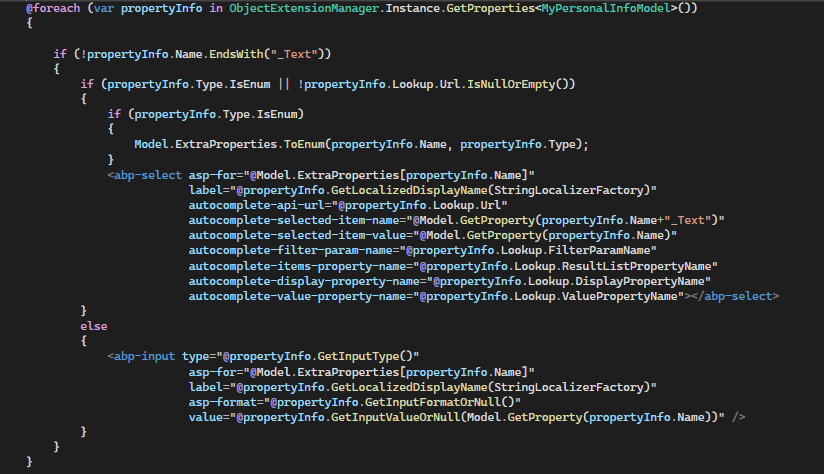
Added the auto mapper profile:
public class PortalIdentityServerAutoMapperProfile : Profile
{
public PortalIdentityServerAutoMapperProfile()
{
CreateMap<ProfileDto, MyAccountProfilePersonalInfoManagementGroupViewComponent.MyPersonalInfoModel>().MapExtraProperties();
CreateMap<IdentitySecurityLog, IdentitySecurityLogDto>(); // can remove 5.2-RC2 https://github.com/abpframework/abp/issues/12070
}
}
- Configured the auto mapper profile in the module:
context.Services.AddAutoMapperObjectMapper<PortalIdentityServerModule>();
Configure<AbpAutoMapperOptions>(options =>
{
options.AddProfile<PortalIdentityServerAutoMapperProfile>(validate: true);
});
Appreciate your assistance.
- ABP Framework version: v5.1.4
- UI type: Angular / MVC
- DB provider: EF Core
- Tiered (MVC) or Identity Server Separated (Angular): yes
For the Web.Public MVC Project, we require certain menu items are available/unavailable based on the state of the user. I think the right approach is to use DI to inject the interface for the application service I want to use to get the data.

However, I can't add the interface to the constructor of the MenuContributor class because it would be required in the module class itself:

I've read the dependency injection section of the guide and think that I should be using property injection but it's not clear to me how I can get an instance of the interface: https://docs.abp.io/en/abp/5.2/Dependency-Injection#property-injection
Can you please provide some guidance on how to achieve this?
Thanks
If you're creating a bug/problem report, please include followings:
- ABP Framework version: v5.1.4
- UI type: MVC / Angular
- DB provider: EF Core
- Tiered (MVC) or Identity Server Separated (Angular): yes
- Exception message and stack trace:
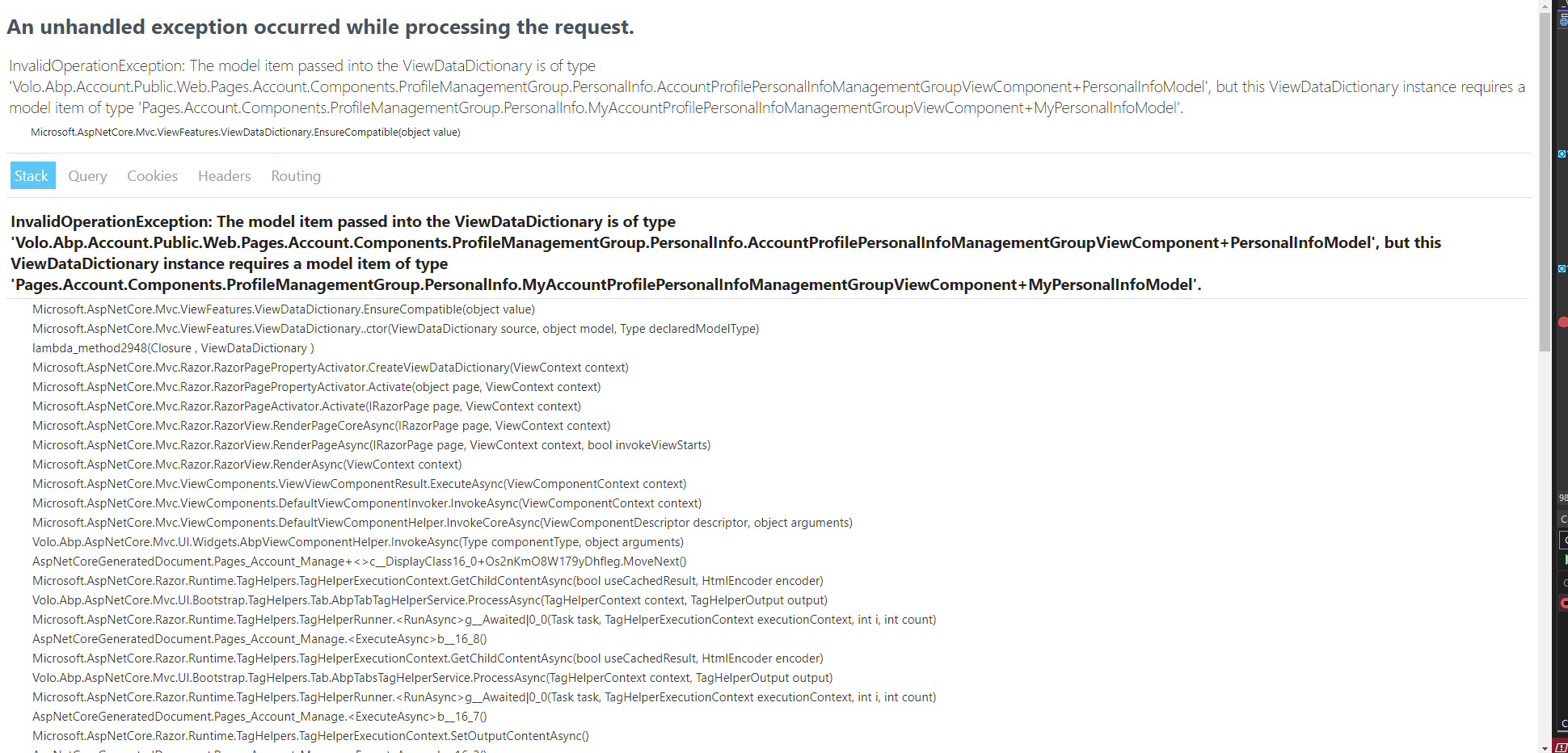
- Steps to reproduce the issue:"
- Created Language enum:

- Added extension property to Identity user:
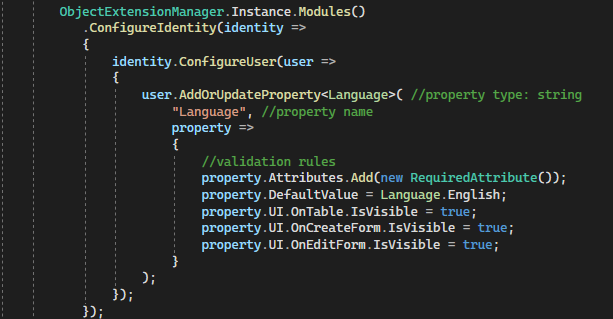
- Added extension properties to the Dtos:

- Works correctly in the angular User create/edit form:
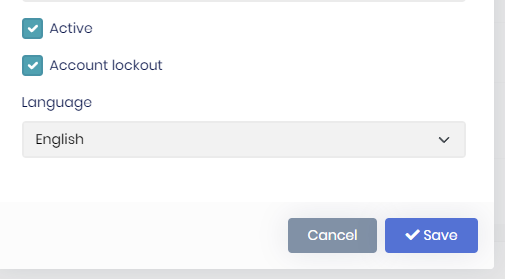
I want the user to be able to update this field too and available in the Account personal info tab.
On the separate Identity server project, I attempted to override the AccountProfilePersonalInfoManagementGroupViewComponent by:
- Creating a new Default.cshtml to include the new Language property
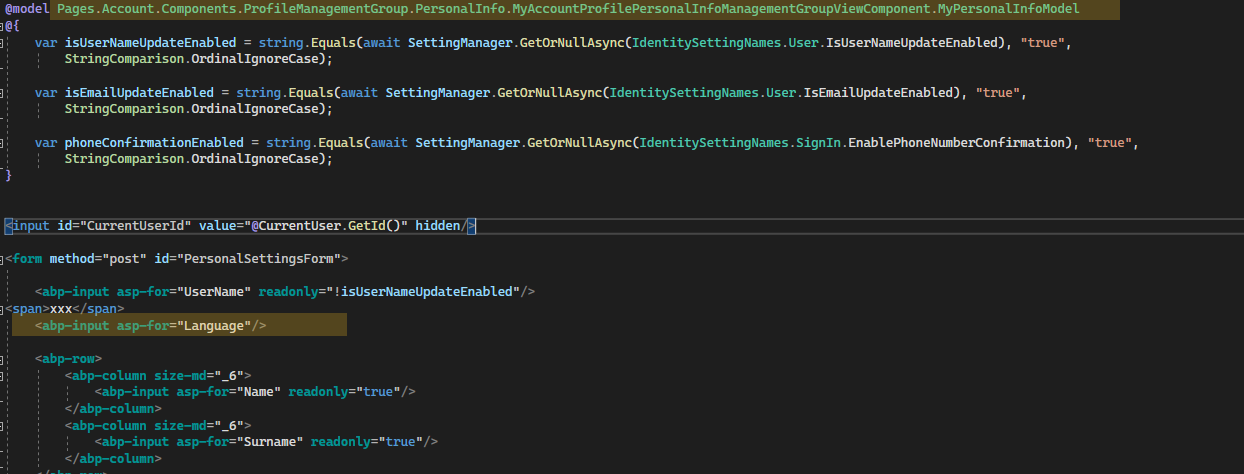
- Creating a new MyAccountProfilePersonalInfoManagementGroupViewComponent class that inherits from AccountProfilePersonalInfoManagementGroupViewComponent
- Creating a new MyPersonalInfoModel class that contains the Language property
- Override the InvokeAsync method in MyAccountProfilePersonalInfoManagementGroupViewComponent to map from ProfileDto to MyPersonalInfoModel

- Adding new AutoMapper Profile to the Identity Server project and creating the map from ProfileDto to MyPersonalInfoModel, including configuration to map the extra property to the Language property in MyPersonalInfoModel

- Configuring the AutoMapper profile in the module:

When I do all this I get the error above.
Can you please let me know the correct approach for extending the PersonalInfo model and UI and ensuring the user can update this property?
Thanks
Hi
I understand LeptonX will first be available for Angular and then versions for Blazor and MVC.
We have a requirement for a mobile web public app and are currently using MVC for the web public app website.
Are you considering how the theme will work with the public website and will it be possible to use the theme when it's generally available for MVC?
Do you have an ETA?
Thanks
v5.1.3 / MVC / Separate Identity server
We are trying to use the extension manager to add extra properties to CmsBlogPosts, but CmsKit does not appear in the list of modules:
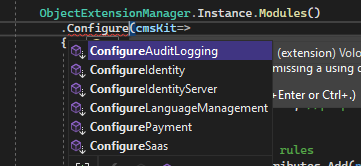
The documentation indicates the feature is supported for all official modules wherever possible:
 https://docs.abp.io/en/abp/latest/Module-Entity-Extensions
https://docs.abp.io/en/abp/latest/Module-Entity-Extensions
Does the CmsKit modules support extensions?
Is the list above the exhaustive list of modules that do support the feature?
Thanks
- ABP Framework version: v5.1.1 & 5.1.2
- UI type: Angular / MVC / Blazor
- DB provider: EF Core / MongoDB
- Tiered (MVC) or Identity Server Separated (Angular): yes / no
- Exception message and stack trace:
-
- Steps to reproduce the issue:"
I am having issues with version 5.1 of the framework and these issues are causing delays in our project. Consequently, I am trying to revert to 5.0.0 and I am experiencing difficulties in doing that.
I need to baseline the generated project using v5.0.0 to manually compare the code with our v5.1.2 version and revert the code.
I uninstalled abp cli and suite: dotnet tool uninstall --global Volo.Abp.Suite dotnet tool uninstall --global Volo.Abp.Cli
I then reinstalled v5.0.0: dotnet tool install -g volo.abp.cli --version 5.0.0 dotnet tool install -g Volo.Abp.Suite --add-source https://nuget.abp.io/XXXXXXXXXXX/v3/index.json --version 5.0.0 abp login XXXXX --organization XXXXXX -p XXXXXX
When I start abp suite, it indicates 5.0.0:

When I create a new solution, abp suite creates it as 5.1.2:

Package references are all 5.1.2:

I am under the impression that installing specific versions of the cli & suite will generate based on that version template?
Can you please help get me back to 5.0.0?
Thanks Jamie
